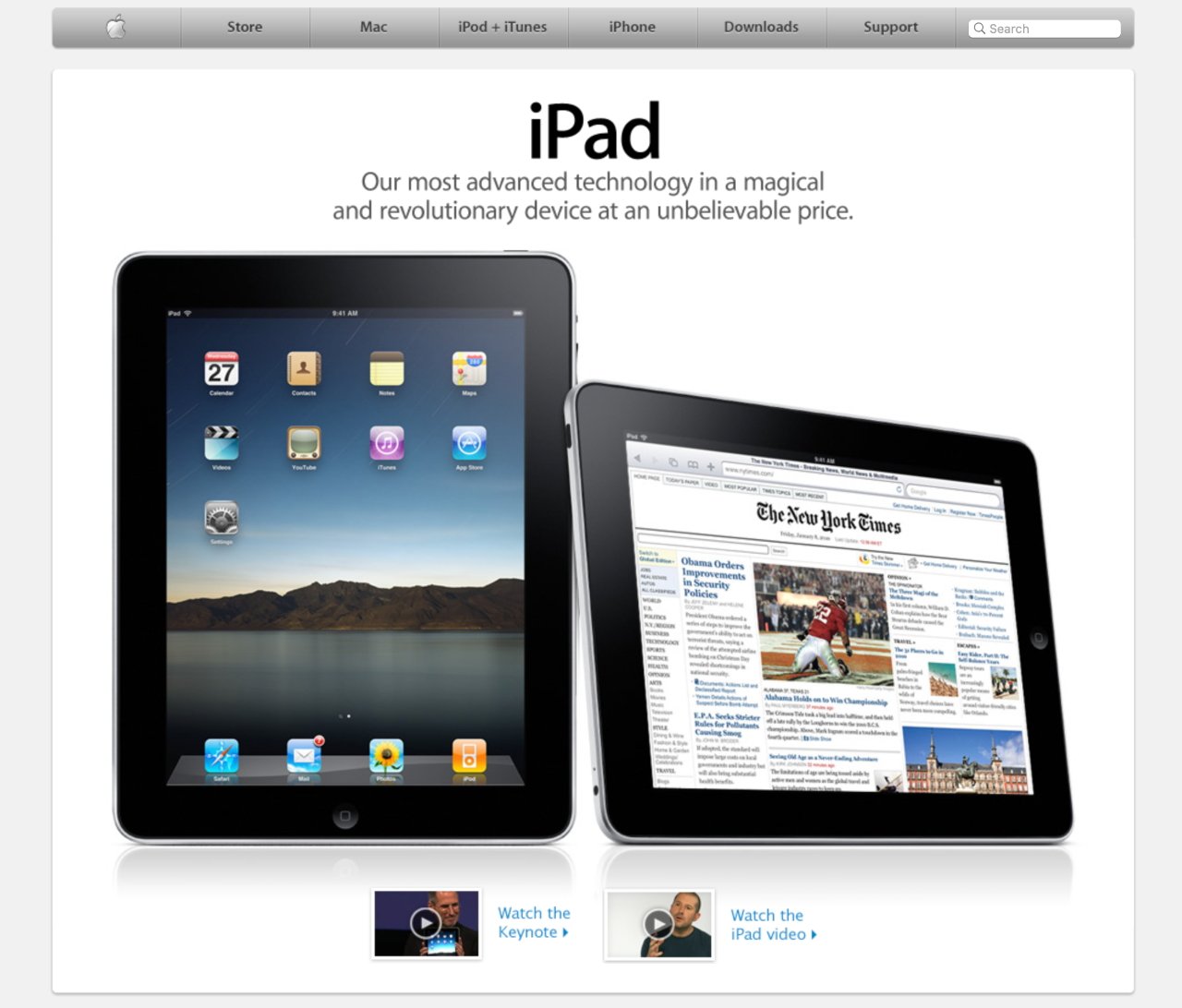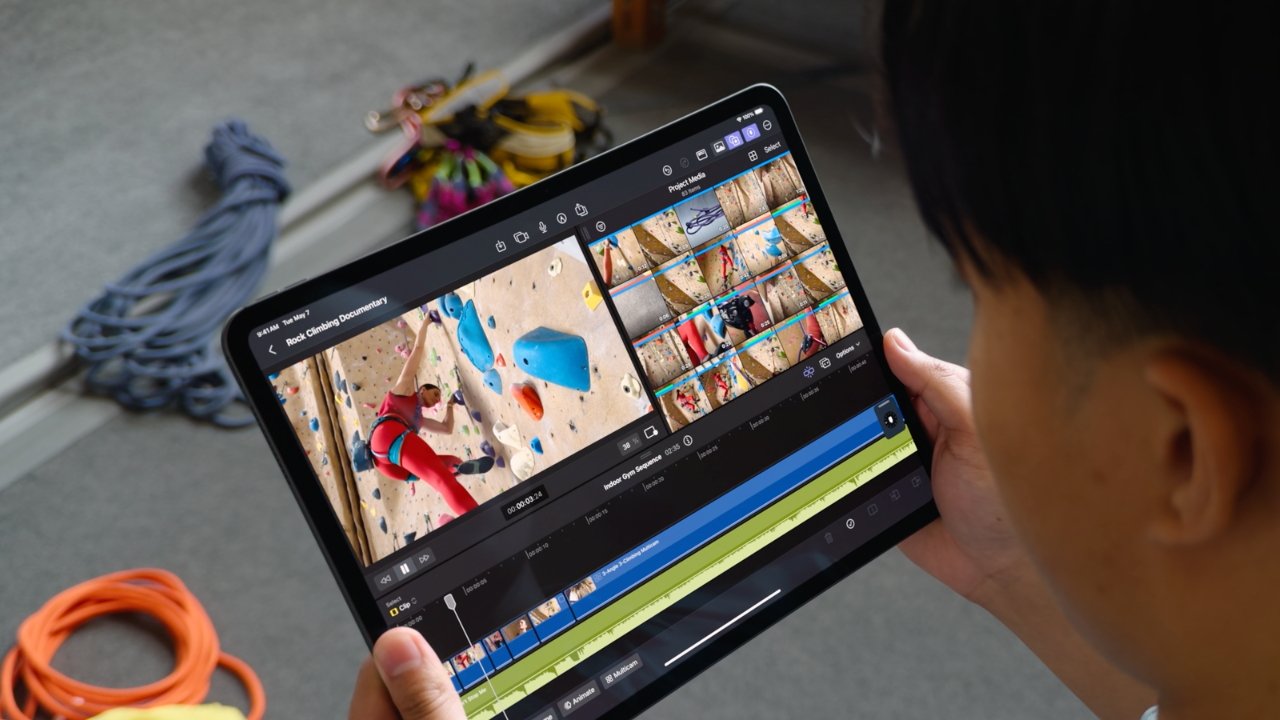It's still a slab of glass, has no serious competitors, and uses radically different technology than you'd expect for a product more than a decade old, but the 2024 iPad still lives up to Steve Jobs' original vision for the product.
There's an argument that the new iPad Air and iPad Pro models are just spec bump models, that they're the same as always, just a little faster. That ignores the new screens, or at least the larger screen first brought to the iPad Air.
It's not an unreasonable criticism, though, until you look back. Comparing the new 13-inch iPad Pro to the iPad that Steve Jobs so proudly showed off at the original launch is an eye-opener.
Apple gets wide-eyed
But looking back now, one thing that stands out as odd about Apple's original promotion for the iPad is that it shows people being wide-eyed. During an eight-minute paean to the iPad, Jony Ive has his own moment of genuine joy at what Apple has accomplished.
Oddly enough, Scott Forstall has the same look, but he manages to maintain it in almost every shot.
“You know, it's true: When something exceeds your ability to understand how it works, it becomes a kind of magic,” says Jony Ive, Apple's chief designer at the time. “And that's exactly what the iPad is… It's hard to understand how something so simple, so thin and so light could be so capable.”
Back then, every word of it was true and the first time you picked up an iPad you felt its lightness, you marveled at its thinness. You also thought it looked smaller than you expected, but after a few minutes of use you forgot about that and became as engrossed in using it as Steve Jobs kept promising.
But now pick up that original iPad, and everything is different technically and design-wise. Forget the specifications for a moment, only the feeling is different.
For starters, it seems particularly heavy now and somehow that weight feels concentrated, like it's heavier than it should be. Moreover, you once again have the impression that the screen is small, but this time that feeling does not go away so easily.
That may be partly because the bezels around the screen now seem so large they're practically comical.
“The reason why this product is so responsive and you can really feel its performance is because of the custom silicon we designed for this product,” said Bob Mansfield, senior vice president of hardware at the time. “That silicon is called A4, and it was really built by our hardware team in collaboration with our software team.”
“And what that gives you is a level of performance that you can't achieve any other way,” he continued. “It also gives you the efficiency to achieve a battery that lasts all day.”
These days the original iPad seems slow, but just as it can't do much, there's not much you can do with it either. The slowness is noticeable, but the 2010 iPad doesn't have to be much faster because no one is going to run Final Cut Pro on it.
Top specs then and now
Take that 'level of performance you can't achieve any other way'. It's hard to really measure the speed difference between iPads based on different processors, but there are some comparisons you can easily make.
Like the Apple A4 processor in the original iPad was a single-core processor, while the new M4 iPad Pro has 10 CPU cores and 10 GPU cores – not to mention a Neural Engine. Then the new M4 is built on a 3 nanometer process, where the A4 used a 45 nanometer process.
Certain details of the A4 are now strangely difficult to pin down, but a number of sources said at the time that it had 149 million transistors. The M4 has 28 billion transistors.
However different the details may be, these specifications are essentially the same: they are the best possible of their time.
Specifications you can feel
Then there's that “so thin and so light” comment from Jony Ive. The original iPad weighed 1.5 kg, while the new 13-inch iPad Pro weighs 1.28 kg.
That doesn't sound like as much of an advance as any other spec, except that it is. Because that original iPad was concentrated 9.56 inches by 7.47 inches, while the new one is 11.09 inches by 8.48 inches.
The weight is therefore distributed over a much larger size, which seems all the more because relatively little of the front of the new iPad Pro is taken up by bezels.
Then there is also the width. The new 13-inch iPad Pro is 0.2 inches where the original was 0.5 inches.
That's a difference you can really feel, as the original now seems convex. On the other hand, the new one feels fragile. And we're sure that mind-blowing YouTube videos with little scientific accuracy doing just that will appear very soon.
The iPad as a consumption device
Contrary to Jobs' original image of the iPad as an all-purpose tool, the original iPad was so heavily criticized upon release for being solely a device for consuming media and not creating anything that the criticism reached its conclusion. continues today. That's despite being Apple's own “Let Loose” launch event video created and edited at least partially on iPads.
While you might still want iPads to do more these days (like enabling round-trip editing for Final Cut Pro between iPads and Macs), it's true that the original model was significantly more limited.
For starters, the original iPad had no cameras. Not at all. The new 13-inch iPad Pro has a 12 MP wide-angle camera on the back, plus an Ultra Wide 12 MP camera with Center Stage on the front.
While you can always watch videos on the iPad, the new 13-inch iPad Pro lets you watch four videos streamed live from iPhones or other iPads at the same time.
Plus, what you watch will look unimaginably better than it was. That 9.7-inch LED-backlit screen on the 2010 iPad had 132 dpi and a resolution of 1024 x 768 pixels.
You know where this is going. The Ultra Retina XDR of the 13-inch iPad Pro is 264 dpi with a resolution of 2420 x 1668 pixels.
But Apple did quote a 10-hour battery life for that original iPad – and exactly the same stands for the 13-inch iPad Pro. Some things never change.
Except maybe the headphone jack, which the original iPad had and the new one didn't.
And the price. The base Wi-Fi-only model of the new 13-inch iPad Pro costs $1,299, while the original iPad cost $499.
Although that will be approximately equal to $715 in 2024. Today, you could buy an 11-inch iPad Air and save $116 for a Magic Keyboard.
Still the same concept
Steve Jobs took a clear swipe at the underpowered netbooks of the time, famously positioning the iPad as a “third category of device,” one that fit between the smartphone and the laptop. It had to get better at emailing, web surfing and reading.
“If there is a third category of devices, they will have to be better at these types of tasks than a laptop or a smartphone,” he said. “Otherwise it has no reason to exist.”
But Jobs later went further, saying that devices like the iPad would replace PCs, including Macs. More than a decade after he said that, he's partially right.
“When we were an agricultural nation, all the cars were trucks because that's what you needed on the farms,” he said later. in 2010. “PCs will look like trucks… they will still be there [but only] one in X people will need them.”
Wisely he did not define the variable X.
Today, sales figures show the iPad selling in about the same numbers as the Mac it thought it would replace. But when you look around at what the iPad is used for and where, it's hard not to think he was right about the future.
The iPad may have started out as a third category of device. Sticking to the original concept, it is no longer a companion to the iPhone and MacBook Pro.
Instead, for so many users, including our own Wesley Hilliard, it has become capable enough to be theirs main computing device.



